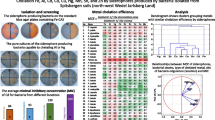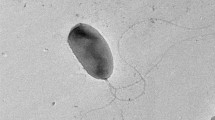Abstract
Recently, heavy metals have been shown to have a stimulating effect on siderophore biosynthesis in various bacteria. In addition, several studies have found that siderophore production is greater in bacteria isolated from soil near plant roots. The aim of this study was to compare the production of siderophores by bacterial strains isolated from heavy metal-contaminated and uncontaminated soils. Chrome azurol sulphonate was used to detect siderophore secretion by several bacterial strains isolated from heavy metal-contaminated and rhizosphere-uncontaminated soils with both a qualitative disc diffusion method and a quantitative ultraviolet spectrophotometric method. Siderophore production by rhizosphere bacteria was significantly greater than by bacteria isolated from contaminated soil. The Pearson’s correlation test indicated a positive correlation between the amount of siderophore produced by bacteria isolated from the rhizosphere using the quantitative and qualitative detection methods and the amount of heavy metal in the soil. However, a significant negative correlation was observed between the amount of siderophore produced by bacteria isolated from heavy metal-contaminated soil and the amount of heavy metal (r value of −0.775, P < 0.001).


Similar content being viewed by others
References
Abou-Shanab RI, Delorme TA, Angle JS, Chaney RL, Ghanem K, Moawad H, Ghozlan HA (2003) Phenotypic characterization of microbes in the rhizosphere of Alyssum murale. Int J Phytoremediation 5:367–379
Anderson TA, Guthrie EA, Walton BT (1993) Bioremediation. Environ Sci Technol 27:2631–2636
Antoun H, Kloepper JW (2001) Plant growth promoting rhizobacteria. In: Brenner S, Miller JF (eds) Encyclopedia of genetics. Academic Press, London, pp 1477–1480
Barzanti R, Ozino F, Bazzicalupo M, Gabbrielli R, Galardi F, Gonnelli C, Mengoni A (2007) Isolation and characterization of endophytic bacteria from the nickel hyperaccumulator plant Alyssum bertolonii. Microb Ecol 53:306–316
Barriuso J, Ramos B, Lucas JA, Probanza A, García-Villaraco A, Gutiérrez MF (2008) Ecology, genetic diversity and screening strategies of plant growth promoting rhizobacteria (PGPR). In: Ahmad I, Pichtel J, Hayat S (eds.) Plant–bacteria interactions: strategies and techniques to promote plant growth. Wiley VCH Publisher, Weinheim, pp 1–17
Belimov AA, Hontzeas N, Safronova VI, Demchinskaya SV, Piluzza G, Bullitta S, Glick BR (2005) Cadmium-tolerant plant growth- promoting bacteria associated with the roots of Indian mustard (Brassica juncea L. Czern.). Soil Biol Biochem 37:241–250
Budzikiewicz H (1993) Secondary metabolites from fluorescent pseudomonads. Microbiol Rev 104:209–228
Dell’Amico E, Cavalca L, Andreoni V (2005) Analysis of rhizobacterial communities in perennial Graminaceae from polluted water meadow soil, and screening of metal-resistant, potentially plant growth-promoting bacteria. FEMS Microbiol Ecol 52:153–162
Dimkpa CO, McLean JE, Britt DW, Anderson AJ (2012) CuO and ZnO nanoparticles differently affect the secretion of fluorescent siderophores in the beneficial root colonizer Pseudomonas chlororaphis O6. Nanotoxicology 6:635–642
Dimkpa CO, Svatoš A, Dabrowska P, Schmidt A, Boland W, Kothe E (2008) Involvement of siderophores in the reduction of metal-induced inhibition of auxin synthesis in Streptomyces spp. Chemosphere 74:19–25
Elad Y, Baker R (1985) The role of competition for iron and carbon in suppression of chlamydospore germination of Fusarium oxysporum. Phytopathology 75:190–195
Elad Y, Chet I (1987) Possible role of competition for nutrition in biocontrol of Pythium damping-off by bacteria. Phytopathology 77:190–195
Hiltner L (1904) Über neuere Erfahrungen und Probleme auf dem Gebiete der Bodenbakteriologie unter besonderer Berücksichtigung der Gründüngung und Brache. Arb Dtsch Landwirtsch Ges 98:59–78
Hofte M, Dong Q, Kourambos S, Krishnapillai V, Sherratt D, Mergeay M (1994) The sss gene product, which affects pyoverdin production in Pseudomonas aeruginosa 7NSK2, is a site-specific recombinase. Mol Microbiol 14:1011–1020
Idris R, Trifonova R, Puschenreiter M, Wenzel WW, Sessitsch A (2004) Bacterial communities associated with flowering plants of the Ni hyperaccumulator Thlaspi goesingense. Appl Environ Microbiol 70:2667–2677
Jing YD, He ZL, Yang XE (2007) Role of soil rhizobacteria in phytoremediation of heavy metal contaminated soils. J Zhejiang Univ Sci B 8:192–207
Karuna G, Pal RB (2010) Siderophores and pathogenicity of microorganisms. J Biosci Tech 1:127–134
Lasat HA (2002) Phytoextraction of toxic metals: a review of biological mechanisms. J Environ Qual 31:109–120
Lemanceau P, Samson R, Alabouvette C (1988) Recherches sur la resistance des sols aux maladies. XV. Comparaison des populations de Pseudomonas fluorescents dans un sol resistant et un sol sensible aux fusarioses vasculaires. Agronomie 8:243–249
Lemanceau P, Bakker P, Dekogel WJ, Alabouvette C, Schippers B (1992) Effect of pseudobactin 358 produced by Pseudomonas putida WSC358 on suppression of Fusarium wilt of carnations by non pathogenic Fusarium oxysporum. Appl Environ Microbiol 58:2978–2980
Leong J (1986) Siderophores: their biochemistry and possible role in the biocontrol of plant pathogens. Annu Rev Phytopathol 24:187–209
Matzanke BF (1991) Structures, coordination chemistry and functions of microbial iron chelates. In: Winkelmann G (ed) CRC handbook of microbial iron chelates. CRC Press, Boston, pp 15–64
Matzanke BF (1994) Iron storage in fungi. In: Winklemann G, Winge D (eds) Metal ions in fungi, vol 11. Marcel Dekker Inc., New York, pp 179–214
Rajkumar M, Freitas H (2009) Endophytic bacteria and their potential to enhance heavy metal phytoextraction. Chemosphere 77:60–153
SAS Institute Inc, SAS, SAS/STAT® 9.1 User’s Guide. SAS Institute Inc., Cary, NC, USA, 2004
Schwyn B, Neilands JB (1987) Universal chemical assay for the detection and determination of siderophores. Anal Biochem 160:47–56
Šimon T (1999) The effect of increasing rates of nickel and arsenic on the growth of radish and soil microflora. Rostlinna Vyroba 45:421–430
Sinha S, Mukherjee SK (2008) Cadmium-induced siderophore production by a high Cd-resistant bacterial strain relieved Cd toxicity in plants through root colonization. Curr Microbiol 56:55–60
Sumner ME, Miller WP (1996) Cation exchange capacity and exchange coefficients. In: Sparks DL (ed) Methods of soil analysis. Part 3. SSSA Book, vol 5. SSSA, Madison, pp 1201–1229
U.S. Environmental Protection Agency (USEPA) (1994) Microwave assisted acid digestion of sediments, sludges, soils and oil. Method 3051
Winkelmann G (2007) Ecology of siderophores with special reference to fungi. Biometals 20:379–392
Winkelmann G (1991) In: Winkelmann G (ed) Handbook of microbial iron chelates (Siderophores). CRC Press, Boca Raton
Acknowledgments
This study was supported by the National Research Foundation of Korea Grant funded by the Korean government (Project number: NRF-2013R1A1A2011950) and also supported by Kangwon National University.
Author information
Authors and Affiliations
Corresponding author
Rights and permissions
About this article
Cite this article
Hussein, K.A., Joo, J.H. Potential of Siderophore Production by Bacteria Isolated from Heavy Metal: Polluted and Rhizosphere Soils. Curr Microbiol 68, 717–723 (2014). https://doi.org/10.1007/s00284-014-0530-y
Received:
Accepted:
Published:
Issue Date:
DOI: https://doi.org/10.1007/s00284-014-0530-y




